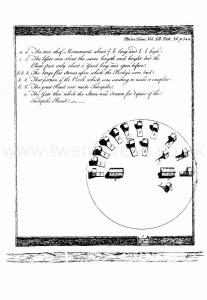Wardlow Barrow 1 Account
Wardlow Barrow 1 Account is in Prehistory.
Full title: XC. An Account of a remarkable Monument found near Ashford in Derbyshire: In a Letter from the Reverend Mr. Evatt, of Afhford, to Mr . Whitehurft, of Derby. Communicated by Benjamin Franklin, LL.D. F. R. S.
Dear Sir, Ashford, October 5, 1761.
Read 13 May 1761.
The following is the best account I am able to give you of the curiosity I told you of, discovered some time ago in our neighbourhood; to which I have added, an imperfect drawing, that, I hope, Will, notwithstanding, give you a tolerable idea of it.
In the year 1759, as fome people were making a turnpike-road through the village of Wardlow, near this place, they thought proper to take out of an adjoining field, a heap of ftone, that had lain there time immemorial, and without any tradition, that I could find, why it was thrown together in that place, although it was manifeft it was a work of art. Here, to their great furprize, upoh removing the ftone, they found a monument [Map], to the memory of feventeen perfons, or more, who had been there interred, in the manner exprdled in the drawing annexed. [Vide Tab. XV.]
The bodies appeared to have been laid upon the furface of the ground, upon long flat ftones, and their heads and breafts protected from the incumbent weight of ftone, by fmall walls made round them, with a flat ftone over the top, as I have endeavoured to exprefs in the figures, excepting the two capital ones, marked a, a, which were walled up, and covered from head to foot, in the form of a long chest, with a stone cover over each.
Upon removing the rubbish, many bones, such as jaw-bones, teeth, and the like, were found undecayed; but none at all of the larger bones of the body, that I could learn. The heap of stones, that covered them, was 32 yards in diameter, and about five feet high; and the stones, of which the coffins, or tombs, were composed, appear, very plainly, to have been taken from a stone quarry, above a quarter of a mile distant. In the drawing, you see a part of the circle is vacant; but it is probable it was not so, as there were found several bones and teeth in that space; the cause might be, that as part lay next the road, it might have met with an accidental difturbance; or, what is yet more likely, the people that came to lead the stone away, beginning on that side of it, destroyed that part, before they were aware that it was any-ways remarkable, or worthy note.
There is one circumstance, that seems to denote the monument to have been rather modern; which is this. It appears, from the best observations I could make, that the wall, marked 4 , was erected before the monument was made, as I think it hardly probable, that the persons, who built it, would be at the trouble to remove that part of the circle, that was without, for the fake of building a field-wall, entirely level; which is the cafe, for all that portion of the circle, from the infide of the wall, was as level as any other part of the field: and as walls, I apprehend, are not of very antient date here, (if the above be a fact) I cannot help concluding, that the monument mull have been erected in fome or other of the wars of the houfes of York and Lancafter, or later. But this is only conjecture, and muft be fubmitted to the judgment of the more curious, or thofe who may have heard of, or feen, fome fimilar ones; for my part, in my reading, I have not met with any thing at all like it. The feveral coffins were about two feet high each; the two complete ones about 7.6 long each; and the others had the fiat ftone nearly the lame length; but the covering extended only as far as the breaft.
hefe are all the particulars I am now able to give you, of this remarkable monument. It is now totally deftroyed. If any of your friends, to whom you may, poffibly, communicate this, could afcertain, in any meafure, the date of it, Ihould be extremely glad to hear it from you, as, I think, it would greatly affill me in tracing fome other remarkable curiolities in our neighbourhood, by way of preparation for a natural hiftory of this part of our county.
I am.
Dear Sir,
Your sincere friend,
and humble servant,
Samuel Evatt.
XCI. Dejcriptia
